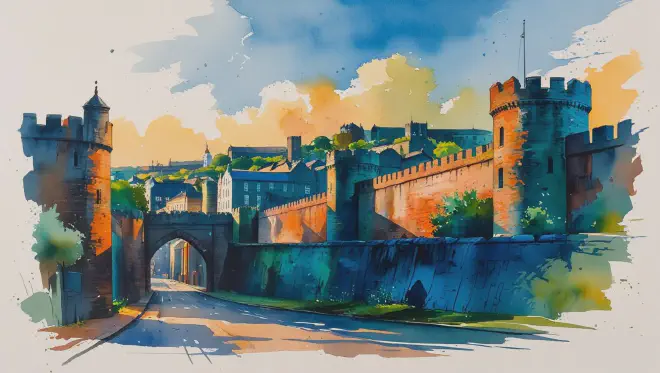Introduction
Nestled along the banks of the River Foyle, Londonderry—affectionately called “Derry” by its residents—is Northern Ireland’s second-largest city, yet it radiates an intimate warmth that immediately embraces visitors. This remarkable walled city, with its 17th-century fortifications still standing complete and unbroken, represents one of Europe’s finest examples of a preserved fortress town.
The city’s charm extends far beyond its historical architecture. Positioned at the northwestern tip of the island of Ireland, it stands resilient against the wild Atlantic winds while being cradled by the gentle flow of the River Foyle. Here, Celtic heritage interweaves with Scottish Planter traditions, creating a tapestry of culture that has emerged from complex historical chapters into an era of peace and hope.
Walking atop the ancient walls that embrace the city center, one gazes out over rolling green hills stretching toward endless blue skies. Yet what strikes visitors most profoundly are the warm smiles of the people encountered on every street corner, and the melodic sounds of Gaelic phrases that dance through conversations conducted in richly accented English.
The air itself tells stories here—carrying the salt tang of distant seas mingled with the sweet scent of countryside meadows, while church bells mark time’s passage across centuries of human experience.

Day 1: Through the Gates of a Timeless City
The two-hour train journey from Belfast offered a gradually shifting landscape outside my window, transitioning from urban sprawl to pastoral tranquility as I approached Londonderry station. Stepping onto the platform, I was immediately struck by the pristine quality of the air—a blend of maritime salt carried on ocean breezes and the fresh fragrance of distant hills, creating an atmosphere surprisingly pure for a city center.
My guesthouse stood on a quiet cobblestone street within the ancient walls, housed in an 18th-century building where red brick contrasted beautifully with crisp white window frames. A small garden bloomed with colorful flowers at the entrance, and Seamus, the gentle sixty-something owner, greeted me with thickly accented English: “First time in Derry, then?” As he checked me in, he kindly marked recommended sights on a hand-drawn map, his weathered hands moving with practiced familiarity across the paper.
Lunch at a small café near the walls introduced me to Irish stew—a generous bowl filled with tender lamb and root vegetables that warmed both body and spirit. The accompanying soda bread, crispy outside and pillowy within, became perfect when slathered with butter, its earthy simplicity satisfying in ways that sophisticated cuisine rarely achieves.
The afternoon was devoted to exploring the city’s crown jewel: its complete circuit of ancient walls. Walking the 1.5-kilometer perimeter, I felt time suspend itself around these 400-year-old fortifications that remain remarkably intact and beautiful. From the ramparts, the Bogside area spread across the River Foyle—a district once synonymous with conflict now transformed by vibrant murals that speak quietly but powerfully of peace and reconciliation.
Evening brought me to St. Columb’s Cathedral, the 17th-century Protestant cathedral holding the distinction of being Ireland’s first purpose-built cathedral. Sunset streaming through stained glass windows created dancing patterns of colored light that held me transfixed in the sacred silence. Church bells marking day’s end resonated across the entire city, their bronze voices carrying centuries of prayers and hopes.
Night found me at The Gweedore Bar, where dim lighting cast warm shadows across wooden fixtures and local residents gathered in animated conversation. When I ordered a Guinness, Paddy the bartender struck up conversation: “Visitor, are you? How are you finding Derry?” He spoke of the city’s musical heritage, explaining how it had produced numerous celebrated musicians. Indeed, fiddle and whistle melodies drifted from the bar’s depths, where several locals had begun an impromptu traditional session.
Back in my small guesthouse room that evening, opening the window revealed the gentle murmur of the river beyond the walls and distant church bells blessing the quiet night. From my first day, I sensed this city’s remarkable capacity for embrace—a place bearing history’s weight yet never losing hope, where people’s warmth seemed to envelop the entire urban landscape like an invisible but palpable presence.
Day 2: Rivers, Hills, and Musical Conversations
Morning began with a traditional Ulster Fry in the guesthouse dining room—bacon, sausage, fried egg, black pudding, grilled tomato, and mushrooms filling the plate in hearty abundance. Mary, Seamus’s wife, poured tea that was robust yet smooth, the perfect awakening brew that seemed to seep into my very bones with its comforting strength.
The River Foyle beckoned for morning exploration along its dedicated walkway. The Waterside district across the water presented a picturesque panorama, with river surface reflecting sky blue and banks adorned in various shades of green, creating a scene worthy of canvas and oil paints. An elderly woman I encountered along the path shared: “This river is our pride, you know.” Indeed, the Foyle clearly serves as more than geographical boundary for Derry’s residents—it flows as part of their daily existence, a source of spiritual sustenance and communal identity.
Crossing the Peace Bridge to reach the opposite bank, I walked this beautiful pedestrian span opened in 2011, literally serving as a “bridge of peace” connecting previously divided communities. From its graceful arch, the River Foyle flowed serenely below while waterfowl glided with elegant ease, their peaceful presence soothing to observe.
Lunch at a riverside restaurant featured locally caught salmon, grilled to perfection and accompanied by colcannon—a traditional combination of potatoes and cabbage that, while simple, offered depths of flavor reflecting the land’s natural abundance. Apple tart for dessert proved exquisite, its tart fruit and flaky pastry enhanced by rich cream, creating moments of pure contentment.
The afternoon called for venturing beyond the city into surrounding hills. Michael, my taxi driver, was Derry-born and bred, regaling me throughout our journey with stories of local history and culture. “The sunset from these hills is something special,” he promised, and his words proved prophetic. The panoramic view from the hilltop took my breath away—the city spreading below, green hills rolling beyond, and the Atlantic’s distant horizon hazily visible. Though the wind carried coolness, its freshness felt invigorating as I stood absorbing the magnificent vista.
Returning to the city, I visited the Arts Centre, where local artists’ works filled exhibition spaces, many exploring themes of civic history and culture. One abstract painting using the ancient walls as its motif particularly impressed me, skillfully expressing past, present, and future hope through bold brushstrokes and thoughtful composition. Aimee, a young staff member, provided insightful commentary on the pieces, conveying the passionate dedication of local creative communities.
Dinner at Sandino’s Café Bar introduced me to an establishment beloved across political and religious divides, its walls decorated with messages of peace and reconciliation. Fish and chips arrived with perfectly crispy batter encasing flaky white fish alongside fluffy chips. Doused in malt vinegar, this simple fare provided deep satisfaction through its unpretentious excellence.
Music found me again that evening at another pub, where young local musicians performed original compositions blending traditional Irish elements with contemporary influences. Watching music forge connections across generations, I witnessed firsthand this city’s remarkable cultural vitality and its ability to honor tradition while embracing innovation.
Day 3: Morning Mist and Farewell Echoes
My final morning arrived with earlier-than-usual waking, the world outside still wrapped in pre-dawn dimness and profound quiet. Deciding to walk the walls once more before breakfast, I stepped into streets empty except for early joggers and dog walkers who cheerfully called “Good morning!” as our paths crossed. Their natural warmth exemplified the character I’d discovered throughout this community.
The ancient walls revealed yet another face in morning mist, their stone surfaces taking on almost mystical qualities in the soft light. Fog-shrouded buildings created an otherworldly atmosphere, as if I’d slipped through time’s fabric into another era entirely. Settling on a wall-top bench, I watched the sky gradually brighten while reflecting on two days filled with unexpected discoveries and genuine human connections.
After checking out, I made my way to Guildhall, the neo-Gothic municipal building from 1890 that serves as one of the city’s most recognizable landmarks. Its magnificent stained glass windows depict scenes from Irish history and culture in brilliant colors that seemed to glow like jewels when morning light streamed through the ornate panes.
St. Eugene’s Cathedral provided my next stop—the Catholic cathedral whose soaring spires dominate the skyline. Within its reverent interior, I spent quiet moments appreciating how people of different faiths share common hopes for peace and understanding, regardless of denominational boundaries.
A light lunch near the station featured Irish coffee while I browsed photographs captured over three days, each image triggering vivid memories of experiences and encounters. The café window framed familiar city views that seemed more precious knowing I’d soon depart.
As train departure approached, I returned to collect my luggage, where Seamus and Mary waited at their entrance to bid farewell. “You must come back to see us again,” Mary insisted, her words causing unexpected emotion to well up within me. Meeting such genuinely warm people had transformed this journey from simple tourism into something approaching pilgrimage.
Walking toward the station, I turned once more to survey the complete scene—walls embracing the beautiful cityscape, the River Foyle’s peaceful flow, and green hills extending toward distant horizons. Every detail remained etched clearly in memory’s permanent archive.
As the train pulled away and familiar landscapes began sliding past my window, I felt three days of experiences weaving themselves into a single, coherent narrative within my heart. Londonderry had revealed itself not merely as a tourist destination but as living history itself. The warmth encountered in its people would continue providing comfort and inspiration long after physical distance separated us.
Finally: What Felt Real Despite Being Imagined
This three-day journey to Northern Ireland’s Londonderry existed entirely within imagination’s realm. Yet somehow, the landscapes described through words, the human encounters detailed in prose, and the flavors evoked through description remain as vividly present as authentic memories.
Perhaps travel’s true essence lies not simply in visiting new places, but in the wonder, discovery, and human connections experienced there. Even within imagination’s boundaries, contemplating a land’s history, engaging with its culture, and feeling its people’s warmth genuinely enriches our inner lives.
Just as Londonderry’s walls have endured four centuries to remain standing today, the emotions generated by this imaginary journey will likely persist long in memory’s chambers. Should opportunity ever arise, I would eagerly visit this place in reality, comparing actual experience against these vivid imaginative impressions.
A journey that felt authentically lived despite being entirely imagined—this represents perhaps imagination’s most beautiful gift to human consciousness: the ability to experience genuine emotion and create lasting meaning through the power of words and mental visualization alone.

